CADILLAC ESCALADE 2007 3.G Owners Manual
Manufacturer: CADILLAC, Model Year: 2007, Model line: ESCALADE, Model: CADILLAC ESCALADE 2007 3.GPages: 574, PDF Size: 2.89 MB
Page 391 of 574
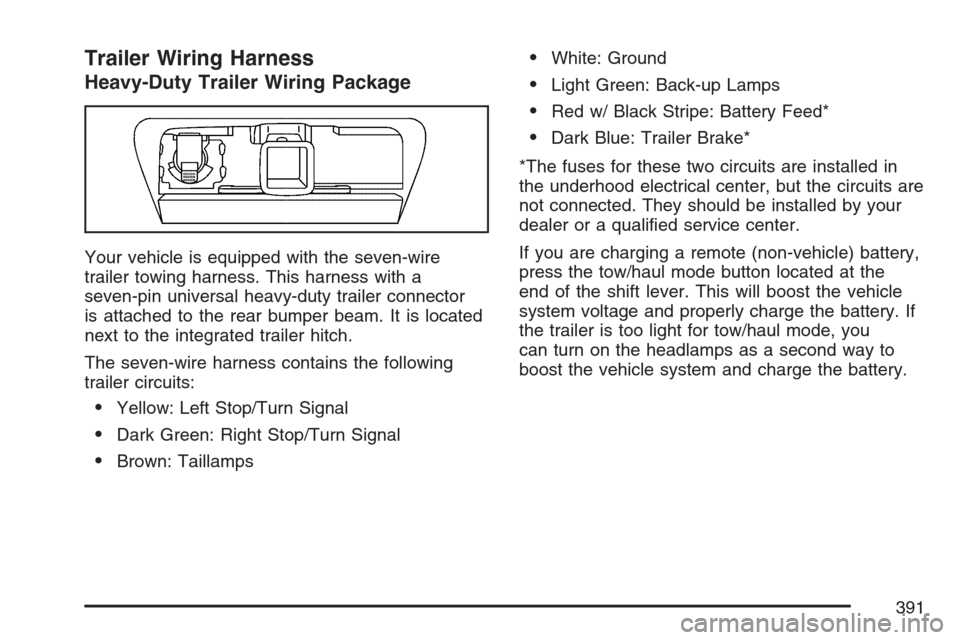
Trailer Wiring Harness
Heavy-Duty Trailer Wiring Package
Your vehicle is equipped with the seven-wire
trailer towing harness. This harness with a
seven-pin universal heavy-duty trailer connector
is attached to the rear bumper beam. It is located
next to the integrated trailer hitch.
The seven-wire harness contains the following
trailer circuits:
Yellow: Left Stop/Turn Signal
Dark Green: Right Stop/Turn Signal
Brown: Taillamps
White: Ground
Light Green: Back-up Lamps
Red w/ Black Stripe: Battery Feed*
Dark Blue: Trailer Brake*
*The fuses for these two circuits are installed in
the underhood electrical center, but the circuits are
not connected. They should be installed by your
dealer or a quali�ed service center.
If you are charging a remote (non-vehicle) battery,
press the tow/haul mode button located at the
end of the shift lever. This will boost the vehicle
system voltage and properly charge the battery. If
the trailer is too light for tow/haul mode, you
can turn on the headlamps as a second way to
boost the vehicle system and charge the battery.
391
Page 392 of 574
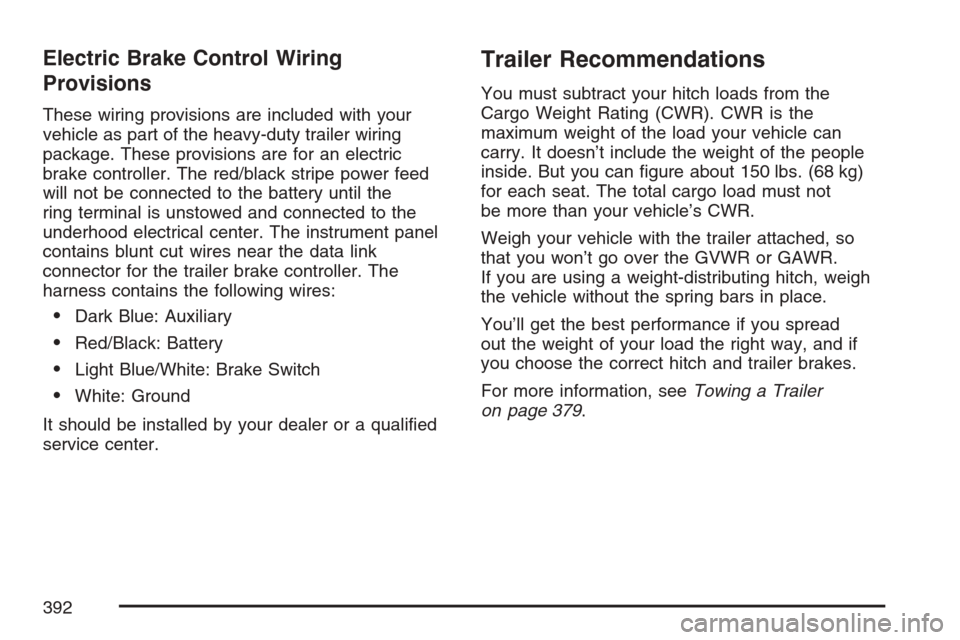
Electric Brake Control Wiring
Provisions
These wiring provisions are included with your
vehicle as part of the heavy-duty trailer wiring
package. These provisions are for an electric
brake controller. The red/black stripe power feed
will not be connected to the battery until the
ring terminal is unstowed and connected to the
underhood electrical center. The instrument panel
contains blunt cut wires near the data link
connector for the trailer brake controller. The
harness contains the following wires:
Dark Blue: Auxiliary
Red/Black: Battery
Light Blue/White: Brake Switch
White: Ground
It should be installed by your dealer or a quali�ed
service center.
Trailer Recommendations
You must subtract your hitch loads from the
Cargo Weight Rating (CWR). CWR is the
maximum weight of the load your vehicle can
carry. It doesn’t include the weight of the people
inside. But you can �gure about 150 lbs. (68 kg)
for each seat. The total cargo load must not
be more than your vehicle’s CWR.
Weigh your vehicle with the trailer attached, so
that you won’t go over the GVWR or GAWR.
If you are using a weight-distributing hitch, weigh
the vehicle without the spring bars in place.
You’ll get the best performance if you spread
out the weight of your load the right way, and if
you choose the correct hitch and trailer brakes.
For more information, seeTowing a Trailer
on page 379.
392
Page 393 of 574

Service........................................................ 396
Accessories and Modi�cations................... 396
California Proposition 65 Warning.............. 397
Doing Your Own Service Work.................. 397
Adding Equipment to the Outside of Your
Vehicle................................................... 398
Fuel............................................................. 398
Gasoline Octane........................................ 398
Gasoline Speci�cations.............................. 398
California Fuel........................................... 399
Additives................................................... 399
Fuels in Foreign Countries........................ 400
Filling the Tank......................................... 401
Filling a Portable Fuel Container............... 403
Checking Things Under the Hood.............. 404
Hood Release........................................... 405
Engine Compartment Overview.................. 406
Engine Oil................................................. 407
Engine Oil Life System.............................. 410
Engine Air Cleaner/Filter............................ 412
Automatic Transmission Fluid.................... 415
Engine Coolant.......................................... 419Coolant Surge Tank Pressure Cap............ 422
Engine Overheating................................... 422
Overheated Engine Protection
Operating Mode..................................... 424
Cooling System......................................... 425
Engine Fan Noise..................................... 430
Power Steering Fluid ................................. 430
Windshield Washer Fluid........................... 431
Brakes...................................................... 433
Battery...................................................... 436
Jump Starting............................................ 437
All-Wheel Drive........................................... 443
Rear Axle.................................................... 444
Front Axle................................................... 445
Headlamp Aiming........................................ 446
Bulb Replacement....................................... 449
High Intensity Discharge (HID) Lighting..... 449
Back-Up Lamps......................................... 449
License Plate Lamp................................... 451
Replacement Bulbs................................... 451
Section 5 Service and Appearance Care
393
Page 394 of 574
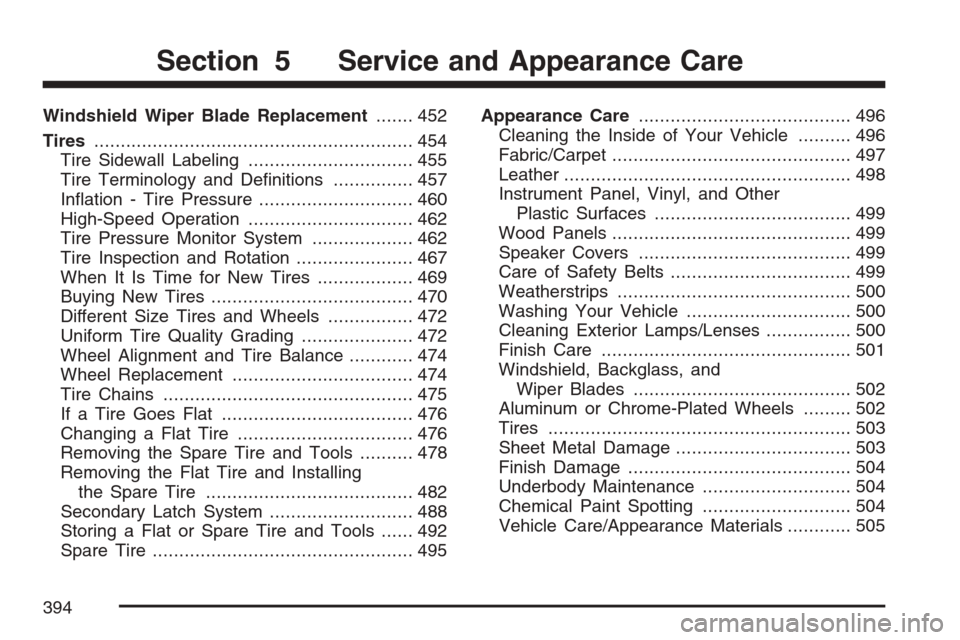
Windshield Wiper Blade Replacement....... 452
Tires............................................................ 454
Tire Sidewall Labeling............................... 455
Tire Terminology and De�nitions............... 457
In�ation - Tire Pressure............................. 460
High-Speed Operation............................... 462
Tire Pressure Monitor System................... 462
Tire Inspection and Rotation...................... 467
When It Is Time for New Tires.................. 469
Buying New Tires...................................... 470
Different Size Tires and Wheels................ 472
Uniform Tire Quality Grading..................... 472
Wheel Alignment and Tire Balance............ 474
Wheel Replacement.................................. 474
Tire Chains............................................... 475
If a Tire Goes Flat.................................... 476
Changing a Flat Tire................................. 476
Removing the Spare Tire and Tools.......... 478
Removing the Flat Tire and Installing
the Spare Tire....................................... 482
Secondary Latch System........................... 488
Storing a Flat or Spare Tire and Tools...... 492
Spare Tire................................................. 495Appearance Care........................................ 496
Cleaning the Inside of Your Vehicle.......... 496
Fabric/Carpet............................................. 497
Leather...................................................... 498
Instrument Panel, Vinyl, and Other
Plastic Surfaces..................................... 499
Wood Panels............................................. 499
Speaker Covers........................................ 499
Care of Safety Belts.................................. 499
Weatherstrips............................................ 500
Washing Your Vehicle............................... 500
Cleaning Exterior Lamps/Lenses................ 500
Finish Care............................................... 501
Windshield, Backglass, and
Wiper Blades......................................... 502
Aluminum or Chrome-Plated Wheels......... 502
Tires......................................................... 503
Sheet Metal Damage................................. 503
Finish Damage.......................................... 504
Underbody Maintenance............................ 504
Chemical Paint Spotting............................ 504
Vehicle Care/Appearance Materials............ 505
Section 5 Service and Appearance Care
394
Page 395 of 574
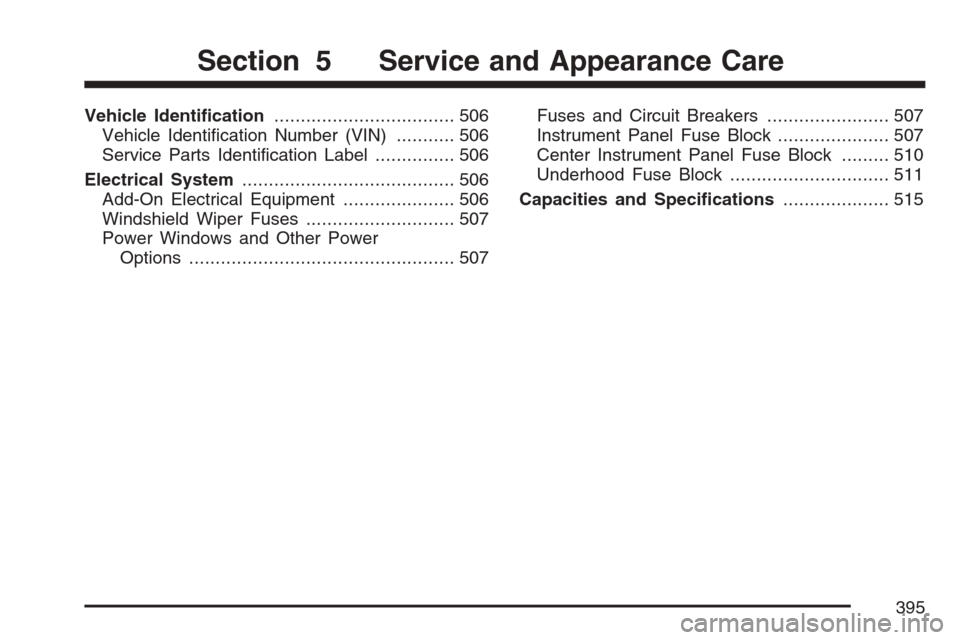
Vehicle Identi�cation.................................. 506
Vehicle Identi�cation Number (VIN)........... 506
Service Parts Identi�cation Label............... 506
Electrical System........................................ 506
Add-On Electrical Equipment..................... 506
Windshield Wiper Fuses............................ 507
Power Windows and Other Power
Options.................................................. 507Fuses and Circuit Breakers....................... 507
Instrument Panel Fuse Block..................... 507
Center Instrument Panel Fuse Block......... 510
Underhood Fuse Block.............................. 511
Capacities and Speci�cations.................... 515
Section 5 Service and Appearance Care
395
Page 396 of 574
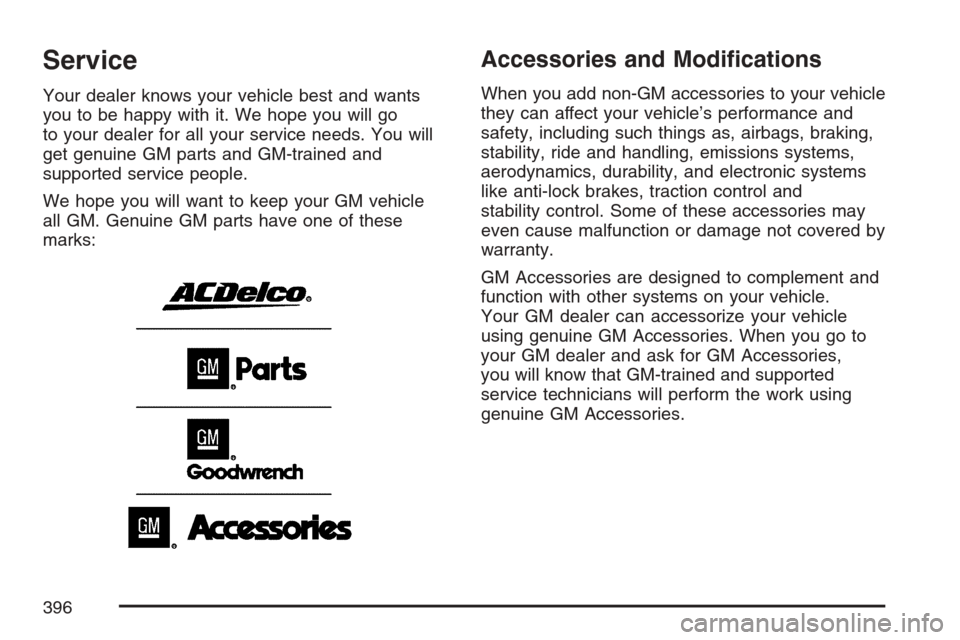
Service
Your dealer knows your vehicle best and wants
you to be happy with it. We hope you will go
to your dealer for all your service needs. You will
get genuine GM parts and GM-trained and
supported service people.
We hope you will want to keep your GM vehicle
all GM. Genuine GM parts have one of these
marks:
Accessories and Modi�cations
When you add non-GM accessories to your vehicle
they can affect your vehicle’s performance and
safety, including such things as, airbags, braking,
stability, ride and handling, emissions systems,
aerodynamics, durability, and electronic systems
like anti-lock brakes, traction control and
stability control. Some of these accessories may
even cause malfunction or damage not covered by
warranty.
GM Accessories are designed to complement and
function with other systems on your vehicle.
Your GM dealer can accessorize your vehicle
using genuine GM Accessories. When you go to
your GM dealer and ask for GM Accessories,
you will know that GM-trained and supported
service technicians will perform the work using
genuine GM Accessories.
396
Page 397 of 574
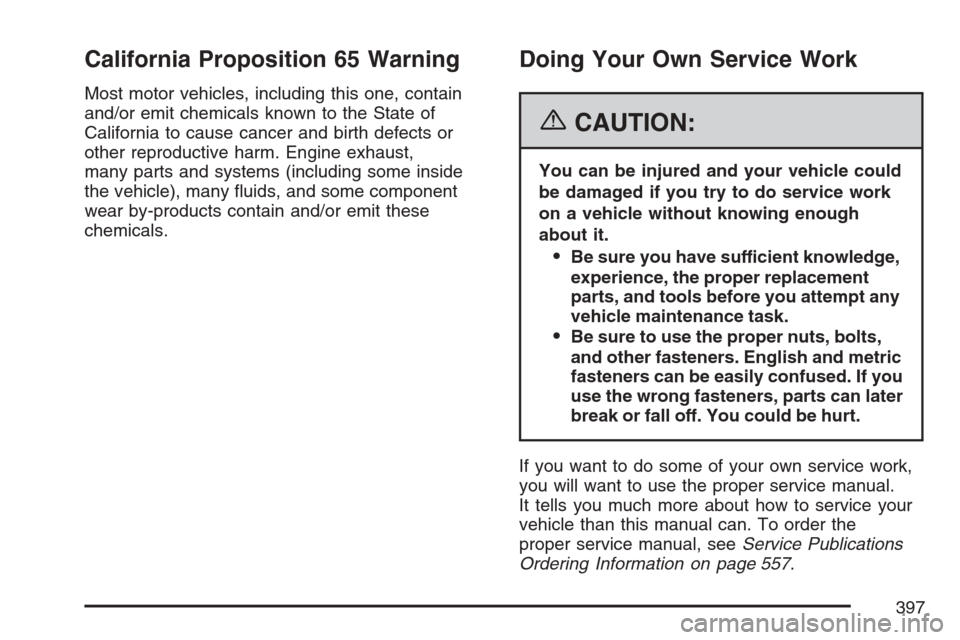
California Proposition 65 Warning
Most motor vehicles, including this one, contain
and/or emit chemicals known to the State of
California to cause cancer and birth defects or
other reproductive harm. Engine exhaust,
many parts and systems (including some inside
the vehicle), many �uids, and some component
wear by-products contain and/or emit these
chemicals.
Doing Your Own Service Work
{CAUTION:
You can be injured and your vehicle could
be damaged if you try to do service work
on a vehicle without knowing enough
about it.
Be sure you have sufficient knowledge,
experience, the proper replacement
parts, and tools before you attempt any
vehicle maintenance task.
Be sure to use the proper nuts, bolts,
and other fasteners. English and metric
fasteners can be easily confused. If you
use the wrong fasteners, parts can later
break or fall off. You could be hurt.
If you want to do some of your own service work,
you will want to use the proper service manual.
It tells you much more about how to service your
vehicle than this manual can. To order the
proper service manual, seeService Publications
Ordering Information on page 557.
397
Page 398 of 574
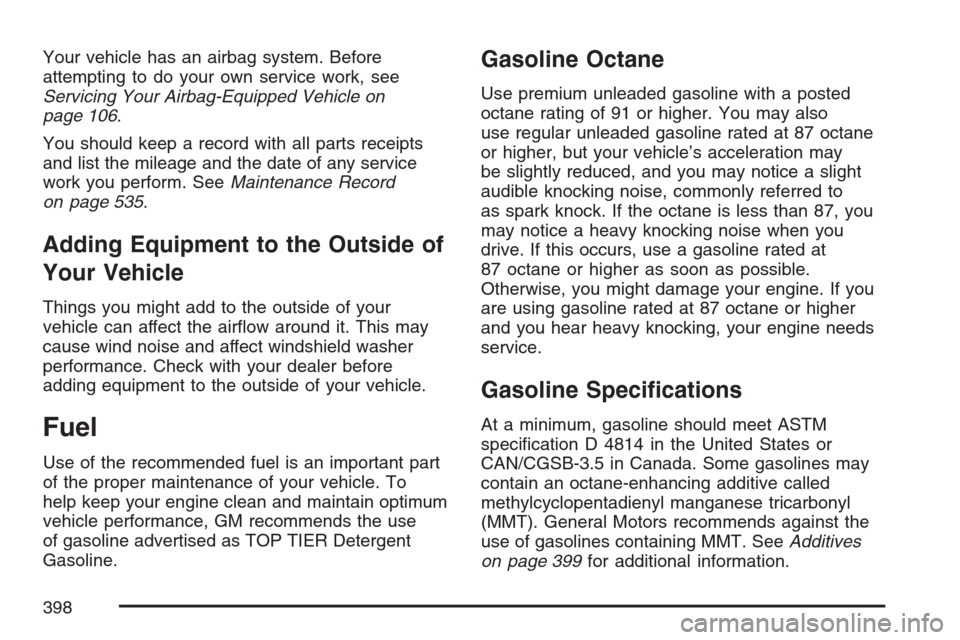
Your vehicle has an airbag system. Before
attempting to do your own service work, see
Servicing Your Airbag-Equipped Vehicle on
page 106.
You should keep a record with all parts receipts
and list the mileage and the date of any service
work you perform. SeeMaintenance Record
on page 535.
Adding Equipment to the Outside of
Your Vehicle
Things you might add to the outside of your
vehicle can affect the air�ow around it. This may
cause wind noise and affect windshield washer
performance. Check with your dealer before
adding equipment to the outside of your vehicle.
Fuel
Use of the recommended fuel is an important part
of the proper maintenance of your vehicle. To
help keep your engine clean and maintain optimum
vehicle performance, GM recommends the use
of gasoline advertised as TOP TIER Detergent
Gasoline.
Gasoline Octane
Use premium unleaded gasoline with a posted
octane rating of 91 or higher. You may also
use regular unleaded gasoline rated at 87 octane
or higher, but your vehicle’s acceleration may
be slightly reduced, and you may notice a slight
audible knocking noise, commonly referred to
as spark knock. If the octane is less than 87, you
may notice a heavy knocking noise when you
drive. If this occurs, use a gasoline rated at
87 octane or higher as soon as possible.
Otherwise, you might damage your engine. If you
are using gasoline rated at 87 octane or higher
and you hear heavy knocking, your engine needs
service.
Gasoline Speci�cations
At a minimum, gasoline should meet ASTM
speci�cation D 4814 in the United States or
CAN/CGSB-3.5 in Canada. Some gasolines may
contain an octane-enhancing additive called
methylcyclopentadienyl manganese tricarbonyl
(MMT). General Motors recommends against the
use of gasolines containing MMT. SeeAdditives
on page 399for additional information.
398
Page 399 of 574
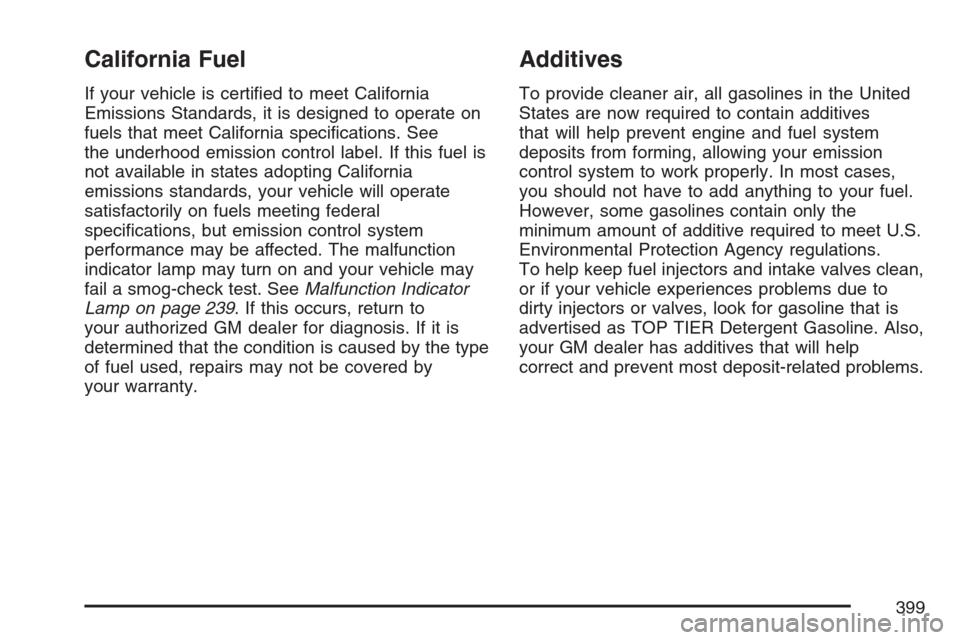
California Fuel
If your vehicle is certi�ed to meet California
Emissions Standards, it is designed to operate on
fuels that meet California speci�cations. See
the underhood emission control label. If this fuel is
not available in states adopting California
emissions standards, your vehicle will operate
satisfactorily on fuels meeting federal
speci�cations, but emission control system
performance may be affected. The malfunction
indicator lamp may turn on and your vehicle may
fail a smog-check test. SeeMalfunction Indicator
Lamp on page 239. If this occurs, return to
your authorized GM dealer for diagnosis. If it is
determined that the condition is caused by the type
of fuel used, repairs may not be covered by
your warranty.
Additives
To provide cleaner air, all gasolines in the United
States are now required to contain additives
that will help prevent engine and fuel system
deposits from forming, allowing your emission
control system to work properly. In most cases,
you should not have to add anything to your fuel.
However, some gasolines contain only the
minimum amount of additive required to meet U.S.
Environmental Protection Agency regulations.
To help keep fuel injectors and intake valves clean,
or if your vehicle experiences problems due to
dirty injectors or valves, look for gasoline that is
advertised as TOP TIER Detergent Gasoline. Also,
your GM dealer has additives that will help
correct and prevent most deposit-related problems.
399
Page 400 of 574
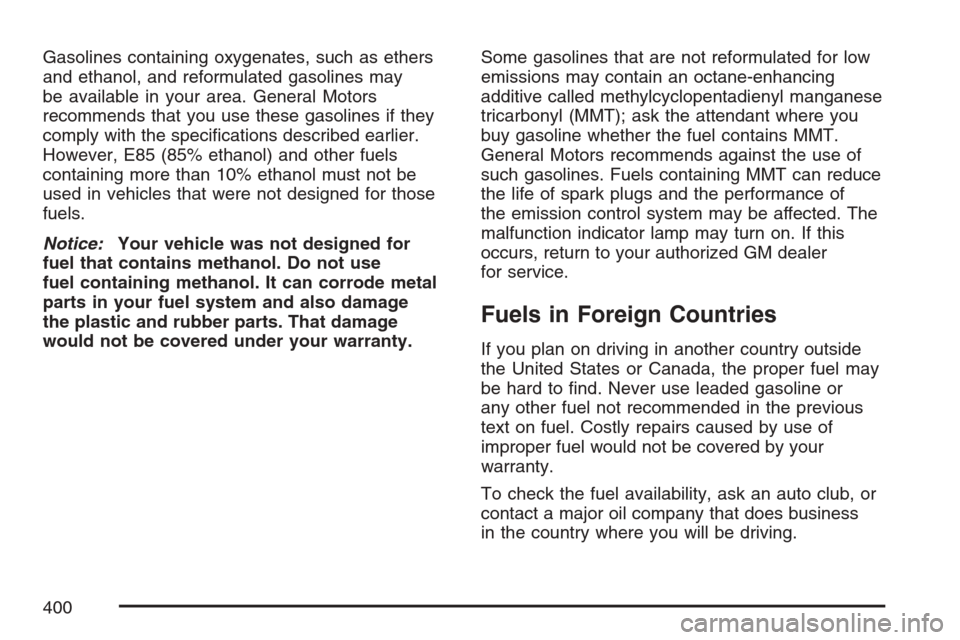
Gasolines containing oxygenates, such as ethers
and ethanol, and reformulated gasolines may
be available in your area. General Motors
recommends that you use these gasolines if they
comply with the speci�cations described earlier.
However, E85 (85% ethanol) and other fuels
containing more than 10% ethanol must not be
used in vehicles that were not designed for those
fuels.
Notice:Your vehicle was not designed for
fuel that contains methanol. Do not use
fuel containing methanol. It can corrode metal
parts in your fuel system and also damage
the plastic and rubber parts. That damage
would not be covered under your warranty.Some gasolines that are not reformulated for low
emissions may contain an octane-enhancing
additive called methylcyclopentadienyl manganese
tricarbonyl (MMT); ask the attendant where you
buy gasoline whether the fuel contains MMT.
General Motors recommends against the use of
such gasolines. Fuels containing MMT can reduce
the life of spark plugs and the performance of
the emission control system may be affected. The
malfunction indicator lamp may turn on. If this
occurs, return to your authorized GM dealer
for service.
Fuels in Foreign Countries
If you plan on driving in another country outside
the United States or Canada, the proper fuel may
be hard to �nd. Never use leaded gasoline or
any other fuel not recommended in the previous
text on fuel. Costly repairs caused by use of
improper fuel would not be covered by your
warranty.
To check the fuel availability, ask an auto club, or
contact a major oil company that does business
in the country where you will be driving.
400